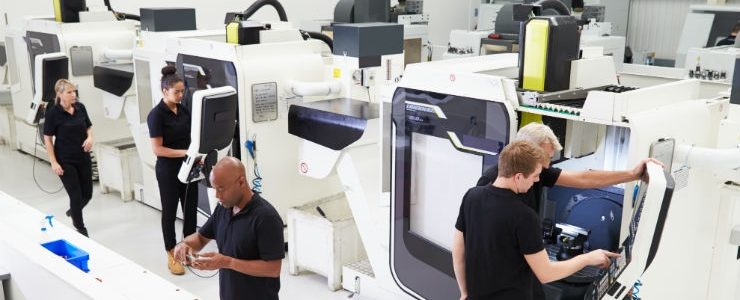One-Stop Repair for Medical Device Manufacturing Equipment

Device manufacturers speed repairs and reduce costs by working with a single source for a full gamut of machine repairs.
From engineering to fabrication, finishing, and assembly, medical device manufacturing incorporates a range of advanced mechanical, hydraulic, and electronic technologies into its processes. With many enterprises utilizing digital design and prototyping systems, automated fabrication, CNC finishing, and multi-axis, laser-based quality assurance systems, the demands for effective and timely repair or replacement of equipment are often critical.
Given the vast array of parts involved, the seemingly straightforward task of maintaining equipment often presents a logistical nightmare that involves farming out components to a variety of specialty repair shops with variable capabilities, quality, pricing, and turnaround time.
Fortunately, the repair services industry is responding by broadening its capabilities to provide more of a one-stop-shop service for medical device fabricators, often with facilities strategically located near major manufacturers or manufacturing regions.
Specialized Equipment
Fabricators of medical devices incorporate manufacturing technologies that are common to many industries, ranging from aerospace to consumer electronics.
For example, companies that make surgical implants, orthotic devices, and medical instruments often employ sophisticated CNC systems to maximize productivity and control. Although CNC systems may be unique in some aspects, many platforms include sub-systems and components that are similar or
common to other industries (such as digital drives and motors), connectivity to many types of tools through standard interfaces (such as Ethernet), and easy integration to many different CAD/CAM systems.
In addition, medical device manufacturers utilize a variety of spindles, spindle motors, arbors, and tools to automatically perform precise machining operations, such as drilling and milling.
There is no shortage of mechanical or hydraulic components. High-purity hydraulic pumps, mixers, motors, cylinders, rotary actuators, pneumatic valves, servo valves, and blowers are used to provide automated handling of liquids, degassing systems, liquid-end assemblies, and flow cells.
Finally, manufacturing systems often contain sophisticated electronic control elements, such as robotics, PLC controllers, environmental sensors, and HMI control panels that are designed to display real-time status information and alarm monitoring while also recording critical production-related data for on-the-fly analysis of events, system troubleshooting, and process improvement.
Given the variety and complexity of machine components, repair or replacement often involves sending specific components out to specialty repair shops. For example, a hydraulic component repair shop does not have the capability to also repair motors; a motor repair shop cannot replace power supplies, I/O, or communication cards in sophisticated PLC systems; and robotic equipment must usually be repaired at a dedicated facility.
Where these services can converge, however, are with larger international repair service companies. Due to their size and expertise in many industries, from automotive to aerospace, they are equipped to offer an array of repair services under one roof.
This includes the repair or replacement of components, including major manufacturer brands for the mechanical (servo motors, gear boxes and gear reducers, brake assemblies, vacuum pumps and blowers, air/fluid pumps, ballscrews, etc.) to the hydraulic (pumps, motors, cylinders, rotary actuators, servo valves, etc.).
In addition, the company can handle sophisticated electronic components including the replacement of controller cards for power supply, I/O, communication, and memory, as well as HMI control panels. For robotic elements, their extensive expertise is used in other industries such as in the automotive manufacturing industry.
Regardless of the type of part, it is important to look for a repair company that will conduct an initial evaluation to identify the probable cause of failure, and then repair and test the part according to the manufacturer’s specifications and test procedures.
Proximity of Repairs
Proximity has many advantages for the manufacturer. First and foremost, having a repair service in close proximity means repairs can be completed faster and the maximum possible uptime maintained. Today, most manufacturing plants need replacement parts quickly due to decreased on-site spare parts inventory. In the event of an emergency, turnaround time is practically negligible. Cases exist where a part has been picked up in the morning, repaired, tested, and returned that same day.
If physical proximity in terms of location has its benefits, there is no relationship closer than having a repair service representative stationed within the plant itself. Some repair service companies provide additional specialized programs like Smart Total Asset Management Program (STAMP), where customers are assigned a full-time, on-site account manager to serve as a one-stop facilitator and manager of all repairable assets within a specific plant.
This level of service includes tracking all repairs, expediting when required, shipping or delivering to and from the nearby repair facility, maintaining database integrity, streamlining and stabilizing procedures, generating a wide variety of reports, and keeping the customer informed throughout the process.
Dick Puhl has 30 years of experience in the industrial component repair industry. Puhl has helped provide solutions for nearly every type of manufacturing plant over the years with a major emphasis on the automotive, aerospace, medical, and food and beverage industries. He is the director for K+S Services, which has multiple repair facilities worldwide.
Read the article here.